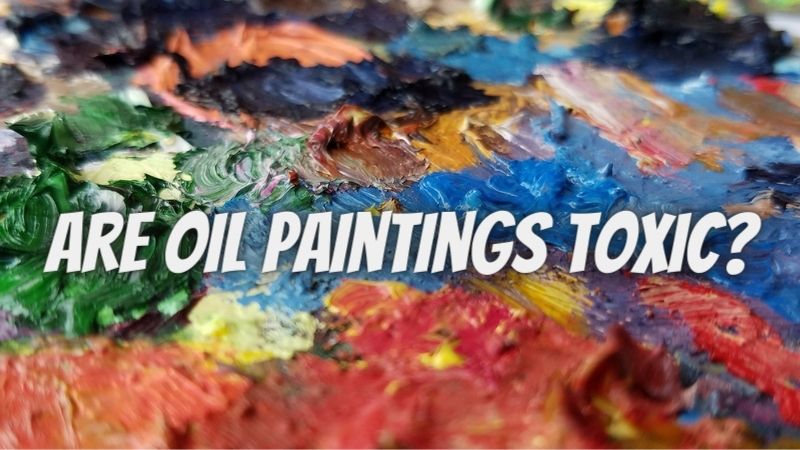Oil paints have long been companions of master artists, aiding them to articulate their distinctive viewpoints onto a piece of canvas. But, often, artists remain unaware of the risks that may be associated with using oil paints.
Even though we’ve come a long way from using lead metals and turpentine in oil paints which can cause harm, many remain cautious of using paints still. This is so from watercolors to oil paints that all contain some chemicals that may or may not harm us.
So, to finally clear this for once and all, let’s delve right into which type of oil paints can potentially cause harm to us and which type cannot. To settle this debate, let’s move onto the following section.
Which Type Of Oil Paints Are Toxic And How Harmful Are They?
It’s said that most oil paints aren’t at all toxic until they are eaten. But, there are toxic pigments contained in oil paints, such as lead-white, cadmium, and cobalt. But, these can only prove toxic if they are eaten or inhaled, which usually doesn’t happen so easily.
Lead was the main ingredient that birthed toxic oil paints. Similarly, mercury, chromates, sulfides, barium, etc., are some other ingredients used in oil paints that proved highly toxic. If ingested, these could have severe impacts on the mental and physical health of a person.
The famous painter Vincent Van Gogh ate his yellow oil paint in an attempt to cheer up his spirits which most probably led to his seizure in 1890. The painter of the wildly famous masterpiece ‘The Starry Night’ who drew it in an asylum ingested the yellow paint, a significant hue in most of his artworks, visibly here.
But, thankfully the oil paints that are available today are more cautiously manufactured, bereft of such toxic chemicals. Even if such substances are present in the oil paint, a warning is present regarding the toxicity and its concentration.
How to Avoid Toxicity in Paints?
The toxicity of oil paints really depends on the kind of solvent and medium used by the artist. Turpentine and mineral spirits are usually toxic components in oil paints as they have a tendency to exude fumes, potentially harming us. But, one can easily deal with this but keeping the tube lid closed and allowing ventilation in the room constantly.
Many oil paints manufacturers produce safe mediums like alkyd mediums that aren’t as harmful. If you still like to be on the safer side, you can choose solvent-free paint and add some oil like the famous linseed oil, walnut, or poppy oil. To further stay away from toxic fumes, make sure you wipe off your brushes in a solvent-free alternative.
You can go another way to ditch the solvent to clean up brushes and go for only oil. You can use any vegetable oil available in your kitchen and dip the paintbrush in it and rinse the bristles thoroughly to do away with the need for solvents.
All Types of Non-Toxic Oil Paints and What to Look For In Them
Thanks to the world’s development that oil paints now have alternatives to choose from which are both environmentally sound and don’t cause us any harm. If you go out in the market, dive into a thorough search for oil paints with labels of “non-toxic” slapped over its outer body.
Moreover, you can go ahead to use water-mixable oil paints instead of the traditionally used oil paints. For these water-mixable paints, you wouldn’t need any solvent to thin out the paint or to clean the paintbrushes, and you can still enjoy the lustrous properties of oil paints.
As an aware customer, do go through the ingredients on the paint tube, and if the pigments have oxides, then you’re probably good to go. Another alternative can be to buy powdered pigments yourself and make your own paints with a tad bit of oil. While you must be thinking how time-consuming it would be, many great artists did it for the best results.
Jackson Pollock’s world-famous drip technique was highly successful and aesthetic as he used house paints for it. He made the texture of the oil paints to suit his dripping needs and did everything himself. Similarly, the Mannerism artist, Paolo Veronese made his masterpiece- The Marriage Feast At Cana by making and mixing his own paints. Even though he had his pupils help him, but behold the consistency of the texture and the life-like properties it holds.
The Bottom Line
Oil paints have an infamous reputation for being notoriously harmful and toxic for artists. But over time, the quality and brands of oil paints have changed for the better to safeguard its users from any harm. Thankfully, non-toxic paints are also available in the market alongside traditional oil paints. Oil paints have bestowed the world with phenomenal art which can be found at https://www.1st-art-gallery.com.




